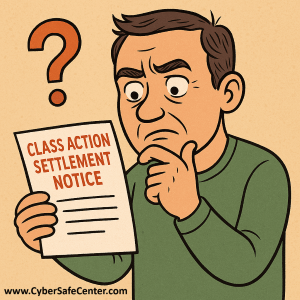- Cyber Safe Center Newsletter
- Posts
- Real Settlement Notices & Amazon's $2.5B Settlement
Real Settlement Notices & Amazon's $2.5B Settlement
Today's newsletter covers how to know if a Settlement Notice is real & Amazon Prime's $2.5B Settlement.

In this issue:
Is this Settlement Notice real?
Amazon Prime's $2.5B Settlement
Data breaches this week
Is this Settlement Notice real?
If you’ve ever opened an email or letter about a class action settlement, your first thought might be that it is a scam. That reaction is understandable because so many fake offers circulate online today. But the truth is, many legitimate class action settlements exist, and some could mean real money for you if you qualify.
Here is an example I've received in email this year for a lab test I ordered in the past. The class member ID (which I blocked out) is a unique alphanumeric number assigned to an individual who is part of a legal case, such as a class action lawsuit. This ID is used by the settlement administrator to identify and track each person as they file a claim for compensation.

Recent real settlement examples include:
AT&T agreed to pay $177 million related to two data breaches in 2024.
Neiman Marcus and Panera Bread settled their own breach cases for $3.5 million and $2.5 million.
Poppi, a prebiotic soda company, will pay $8.9 million to resolve claims about misleading marketing.
Amazon has agreed to a $2.5 billion settlement as I wrote in this article.
Despite these legitimate cases, most people ignore notices. The Federal Trade Commission reports that only about 4 percent of consumers who receive settlement notices actually file a claim. That hesitation often stems from fear of scams.
When you ignore a legitimate class action notice, you usually remain part of the case but do not receive any payout. The company’s liability is reduced while you walk away with nothing. I personally haven't responded to most of the settlement notices I've received so I need to do better about that in the future.
How to Verify a Notice
Search for the case name online and add the words “settlement website.” Avoid clicking links or scanning QR codes in the notice.
Look for official documents or filing information that matches a court record.
Check trusted sites such as ClassAction.org or TopClassActions.com to confirm legitimacy.
Never pay a fee or provide bank details. Real claims may ask for an address or email but never for your Social Security number or payment.
Contact the law firm or claims administrator using independently verified contact information.
Class actions are one of the few ways ordinary consumers can hold large corporations accountable. Scammers might try to trick you, but ignoring every notice can mean losing legitimate compensation. Always verify before you delete.

Amazon Prime's $2.5B Settlement
My household has been an Amazon Prime member for a very long time, but not everyone has or wants Amazon's premiere service for shipping and videos. For those that didn't want it or couldn't easily cancel it, you should be getting some money back soon.
The Federal Trade Commission (FTC) announced on September 25 that Amazon agreed to pay $1.5 billion in refunds to around 35 million customers who were enrolled in Prime without their clear consent. The company will also pay an additional $1 billion in penalties for deceptive practices.
The government found that Amazon used “dark patterns” to trick consumers into signing up for its $139-per-year Prime memberships. These dark patterns included misleading buttons, confusing screens, and a cancellation process that the FTC said was “exceedingly difficult” to complete.
Who is Eligible for Refunds
If you enrolled in Amazon Prime between June 23, 2019, and June 23, 2025, or tried unsuccessfully to cancel during that time, you may qualify. Customers who used three or fewer Prime benefits in a 12-month period will automatically receive up to $51 by December 25, 2025. Others may file claims in 2026 once the FTC opens the next phase of refunds.
The FTC will not contact customers directly about these refunds, so ignore any email, text, or call claiming to represent the agency. (See my other article on how to spot deceptive settlement notices.) Visit FTC.gov/Amazon to check for official updates.
Amazon has pledged to simplify its Prime sign-up and cancellation processes and will be monitored by an independent third party to ensure compliance.
Stay alert and always verify refund announcements at official sources like FTC.gov or on my website CyberSafeCenter.com before responding to any notice.
Data breaches this week
Most of the time these will be companies that you don’t have any personal data with, but scan the names to make sure you aren’t affected.
Prosper peer-to-peer lending: 17.6M accounts: Prosper Data Breach Impacts 17.6 Million Accounts - SecurityWeek
SimonMed Imaging: 1.3M individuals: SimonMed Imaging Data Breach Impacts 1.2 Million - SecurityWeek
Do you have an idea for a future newsletter? Please reply to this email and let me know.
Thank you so much!
Sincerely,
Cassie Crossley
Founder, Cyber Safe Center
https://www.cybersafecenter.com